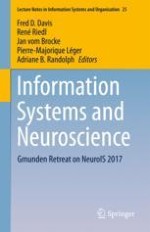2018 | Book
Information Systems and Neuroscience
Gmunden Retreat on NeuroIS 2017
Editors: Prof. Dr. Fred D. Davis, Prof. Dr. René Riedl, Prof. Dr. Jan vom Brocke, Dr. Pierre-Majorique Léger, Prof. Dr. Adriane B. Randolph
Publisher: Springer International Publishing
Book Series : Lecture Notes in Information Systems and Organisation
